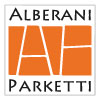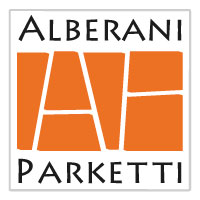The main advantage of a pre-finished two-layered parquet floor is that it has a birch plywood backing that neutralises the natural movements of the noble wood. This valuable technology allows you to choose the type of wood exclusively according to your taste and needs. Therefore the choice of the type of wood for your parquet will be based on aesthetic and design evaluations, since durability and performance are guaranteed and certified on all the products of the Alberani Parketti Collection.Discover the essences from all over the world and choose the tone of colour, brightness and design of the different grains. Our original workmanship and finishes will make your parquet unique.
For a correct installation of parquet, it is sufficient to observe a few simple but fundamental rules.
Mainly check that the humidity of the substrate does not exceed 2.5% by weight.
Should this limit be exceeded, it must be adjusted accordingly. The substrate must be clean, compact and free of cracks to facilitate the glues grip. When laying pre-finished wooden floorings, the humidity must be between 8% and 10%. Wooden floorings require environmental conditions free of excess humidity. It is advisable to store the parquet (boxed) in the rooms where it is to be installed in order to allow it to balance with the environmental conditions. For pre-finished parquet, a few days are sufficient to ensure this acclimatisation.
Only use eco-friendly mono or two-component polyurethane glues, which respect the environment and your health.
For a correct maintenance, the rooms temperature must be of about 18-21 ° C, with an environmental humidity of about 55%.
Thanks to a centesimal tongue-and-groove joint system, our wooden flooring can be either glued or floating using an underfloor mat.
The installation by gluing is the most common type and is the one to be preferred to ensure a perfect solidity of the floor. It is easier to sand and is the recommended installation system in case of underfloor heating.
Floating laying with an underfloor mat is instead more suitable to preserve the existing floor underneath, to avoid an irregular substrate or in case of humidity slightly above the recommended threshold. In all these cases choosing the right mat is fundamental.
Floating installation does not involve the use of adhesives as the parquet is laid on a pad. Special grooves on the sides of each plank guarantee the stability of the floor.
There are high-tech mats on the market, which combine the ability to reduce reverberation from walking or trampling (to be evaluated especially in the case of mezzanines or raised floors), resistance to compression, adaptation to differences in level, thermal insulation, moisture protection and suitability for underfloor heating.
The most suitable mat profile can then be defined on the basis of the particular environmental and subfloor requirements.
Our consultants are happy to help you find the best solution for your needs.
Laying parquet in case of underfloor heating is possible, provided that a few simple rules are observed.
Since the insulating properties of wood contribute to a constant and homogeneous heat distribution and thus to maximised energy savings, pre-finished two-layer parquet is recommended over solid parquet, as it is more resistant to temperature variations.
Laying by gluing is preferable.
Among the precautions to be observed before laying the floor is the verification of the screed, which must be protected by a vapour barrier or screen, at least 6 cm thick, with perimeter joints at walls and other screeds and with adequate thermal insulation. The screed must incorporate the heating/cooling pipes and exceed them by at least 3 cm.
Furthermore, as it is very difficult to remedy any deficiencies in the screed afterwards, it must be perfectly flat, smooth and compact throughout.
Depending on the type of screed, a different curing time is required. This interval is 60 to 90 days for a traditional cement screed, 15 days for a semi-fast-drying screed, 3 days for a fast-drying screed and 7 days for an anhydrite screed.
Then a heating, cooling and stabilizing process is necessary to prepare to screed.
During the heating phase, the system temperature is gradually increased by about 5 ° C per day, until it reaches the maximum operating temperature of about 35 ° C. This temperature must be maintained for about 10 days in order to eliminate excess humidity of the screed. In the following 3 days, it is necessary to gradually cool the system; the last 5 days phase, when the system is off, is called stabilization.
At this point, before laying the parquet, the humidity of the screed must be checked, bearing in mind that the maximum acceptable values are 2.5% by weight for traditional or rapid cement screeds, 0.2% for anhydrite screeds, and 0.3% for concrete screeds.
During these phases the rooms should be regularly aired to allow the moisture that develops to be removed.
Once these operations have been completed, the parquet can be laid.
It is very important that work on laying the parquet floor begins after all other work has been completed, in particular work on exterior windows and doors, plasterboard, plaster, installations and ceramics.
The installation of the parquet floor may be followed by the installation of the interior doors, the kitchen and the touching up of the wall paintings on the lower walls. In these cases, it is advisable to cover the installed floor with specific protection.
For Alberani Parketti respect for the environment and the health of living beings comes first. This is why, in its production process, we use only products that are certified in full compliance with health and environmental regulations, preferring water-based finishes, free of solvents and natural oils, and able to amply satisfy the level of emissions permitted by law.
Thanks to technological progress and its own manufacturing experience, Alberani Parketti has developed different finishing standards that can guarantee authentic surfaces that are always protected.
Varnish finishes, thanks to the presence of ceramic nanoparticles, protect and strengthen the surface of the wood and rank among those most resistant to scratches and abrasions. This finish is very suitable for commercial premises, offices, places of high use and walkways.
Finishes with a high coefficient of water repellency are the UV-drying oils, neutral or coloured, which give naturalness and pleasantness to the touch.
Oils based on natural ingredients, beeswax and water-based varnishes, on the other hand, are the finishes that guarantee maximum authenticity and genuineness of the wood. Their manual application also leaves room for any extraordinary maintenance work, useful for nourishing and restoring any scratches or signs of time.
Wooden floors, like any surface exposed to human contact and the atmosphere, can show signs of this over time.
The workmanship and finishes applied to the wood guarantee, at different levels, protection against abrasion and scratches caused by the daily trampling of the floor.
Simple cleaning and routine maintenance help to protect and preserve the floor, but it is only natural that, over the years, traces of wear and tear will begin to appear on the parquet.
Don’t worry! Unlike other surfaces, the traces of wear and tear that slowly emerge on the wood give the parquet floor a feeling of maturity and dignity. Wood is a living material and, as in an inexorable process of growth and maturing, it changes and matures with us.
In addition, on average every 15-20 years extraordinary maintenance can be carried out to remove the top layer of the floor by sanding. With this operation, the parquet is regenerated, free from any sign of time and ready to receive a new finish.
An Alberani Parketti parquet floor, which boasts a thickness of noble wood between 2.5 and 6 mm, can be sanded several times over the decades.
A parquet floor, therefore, is forever, or so.
The opposite is true for laminate and wood-effect flooring in general. In these cases, in fact, the signs of time represent real damage to the surface and, clearly, the hypothesis of sanding cannot even be considered.
So, once again, beware of imitations.
The two-layer technology used by Alberani Parketti allows the installation of pre-finished parquet in bathrooms, kitchens, and in all those places where the floor is subjected to greater stress produced by water vapour, water splashes, walking with wet feet, etc.
The birch plywood backing, glued transversally to the noble wood fibre, guarantees the product’s stability and tightness, qualities necessary to cope with the particular conditions present in these more “demanding” environments.
In addition, the finishes applied protect the parquet and guarantee, at different levels, water repellence and impermeability.
In addition to these structural features, which make pre-finished parquet suitable for installation also in bathrooms and kitchens, the observance of a few simple rules by the user will increase the degree of resistance and preservation of the parquet. First of all, it is important to remove any small water deposits that may be created and not to leave them standing on the floor for several hours. In addition, opening the doors and windows after a shower or any other event that has produced excess humidity will help to restore optimal atmospheric conditions. Finally, following the simple guidelines suggested for the ordinary and extraordinary maintenance of parquet will allow you to enjoy the pleasure of wood wherever you wish.
Covering the outdoor areas of your home with wood, whether in gardens, poolside areas or terraces, is a stylish choice that adds elegance and value to the environment, while preserving the practicality and functionality required for an outdoor environment.
One of the most suitable wood species for outdoor wooden floors (decking) is Teak, a wood species with exceptional natural water-repellent properties and mechanical resistance. The application on the Teak decking of a finish with oil or vegetable resins for nautical use raises the level of protection of the parquet, keeping it cared for over time and protected from greying and wear.
Generally speaking, decking is made up of solid wood planks with a minimum thickness of 20 mm, widths varying from 90 to 120 mm, and lengths varying from 1800 to 2500 mm.
Alberani Parketti’s creativity and innovation have allowed the company to present to the market the two-layer Decking Plus Teak, composed of noble Teak wood glued to resin-coated marine plywood, a highly appreciated, high-performance and technological product.
Other woods suitable for outdoor flooring include Ipè Lapacho, Angelim Amargoso, thermo-treated pine and ash, Iroko.
Would you like to slightly modify a workmanship of a product that has been proposed to you, make a more intense bleaching or a more delicate planing? Alberani Parketti can manufacture the parquet of your choice on the basis of a sample (or an idea / description).
This is the advantage of being parquet manufacturers: the entire production cycle takes place in our factory in Nociglia (Lecce), and customising a product or going “out of the collection” is very easy for us.
Don’t hesitate to send us your source of inspiration (a photo, a link, a description) and we will develop a tailor-made offer for you.


